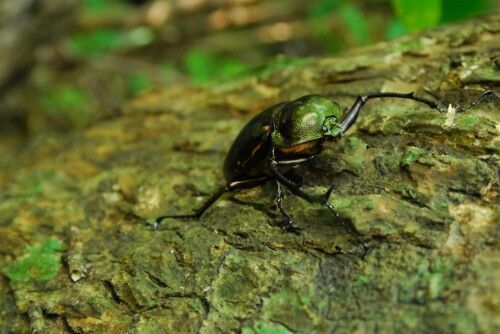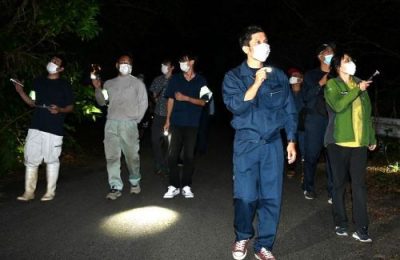Protect the Yambaru Long-Armed Scarab Beetle: In three northern Okinawa villages, 30 people participate in patrol to prevent poaching

The Yambaru long-armed scarab beetle is a rare insect that exists only in northern Okinawa. (Photograph provided by the Ministry of the Environment Yambaru Natural Conservation Office)
October 21, 2020 Ryukyu Shimpo
Northern Okinawa – On October 13, the Joint Council to Prevent Poaching of Yambaru Long-Armed Scarab Beetles (an office of the Okinawa Amami Nature Conservation Office of the Ministry of the Environment) conducted a joint patrol with the villages of Kunigami, Higashi, and Ogimi to prevent poaching. On this day, they patrolled forest roads in the area and did not encounter any poaching activity.
The Yambaru long-armed scarab beetle is Japan’s largest beetle and exists only in the northern part of Okinawa Island. The beetle was discovered in 1983 and declared a natural monument of Japan, a rare domestic species of flora and fauna (the Law for the Conservation of Endangered Species), and endangered according to the IUCN Red List of Threatened Species. Male beetles may have front legs of up to 9 centimeters.

Affiliated individuals who patrol the forest roads. (October 13, Kunigami)
The Joint Council to Prevent Poaching of Yambaru Long-Armed Scarab Beetles was established in 2001. It includes the Ministry of the Environment, forest agencies and other national institutions, the prefectural government, prefectural police, four villages in Northern Okinawa including Kunigami, and the University of the Ryukyus. Originally, the group aimed to protect the Yambaru long-armed scarab beetle, but its protection has expanded to include a species of stag beetle (Neolucanus okinawanus) as well as birds and animals.
The joint patrol on October 13 was joined by approximately thirty people from affiliated organizations. The group split up to patrol 4 routes.
Before setting out, the head of the Ministry of the Environment Yambaru Natural Conservation Office explained poaching. The rare species that are poached in Okinawa and Amami have been found in a variety of places from hotels to post offices and pet shops. It has also been confirmed that rare species from the Nansei Islands are bought and sold online internationally.
Aina Yokoyama, from the Natural Conservation Office, explains, “Showing that we are working to increase awareness of the illegality of the collection itself, and that we are working on countermeasures, will discourage poaching.” She adds, “Even if they are alive, we cannot return creatures to their natural habitats after they have been taken by poachers (due to disease concerns). It’s vital that we prevent poaching in the creatures’ habitats.”
In northern Okinawa, the Ministry of the Environment conducts around two hundred routine patrols annually. The prefectural government also conducts close to two hundred patrols in a year. The Ministry of the Environment patrols forest roads while the prefecture patrols within the forest.
(English translation by T&CT and Ellen Huntley)
Previous Article:Beloved local store to be re-built by third-generation owners after operating for over fifty years
Next Article:Mahi-mahi sun drying process beings under autumn skies at Ginama Port
[Similar Articles]
- Okinawa Prefecture and the Ministry of the Environment patrol Yambaru forest to stop poaching
- Residents patrol Yambaru forest
- After numerous instances of poaching, Okinawa to close hiking trails in Kunigami at night starting August 26, in an effort to protect the Yanbaru long-armed scarab beetle
- Okinawa rail photographed eating its lunch
- In 7 months 17 rats of endangered species designated as natural monument accidentally killed
 Webcam(Kokusai Street)
Webcam(Kokusai Street)


